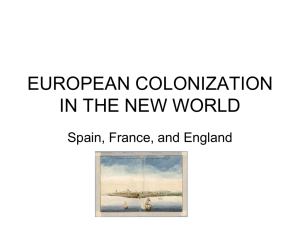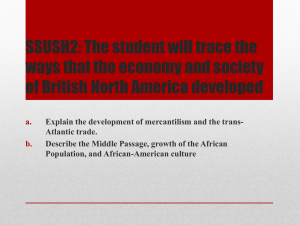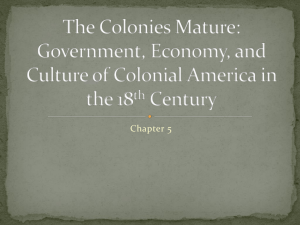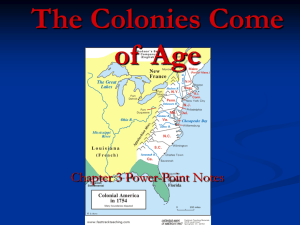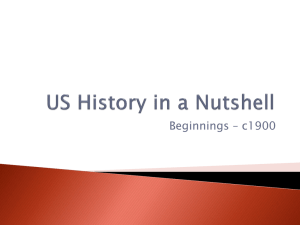CHAPTER 1: BEGINNINGS TO 1763
advertisement
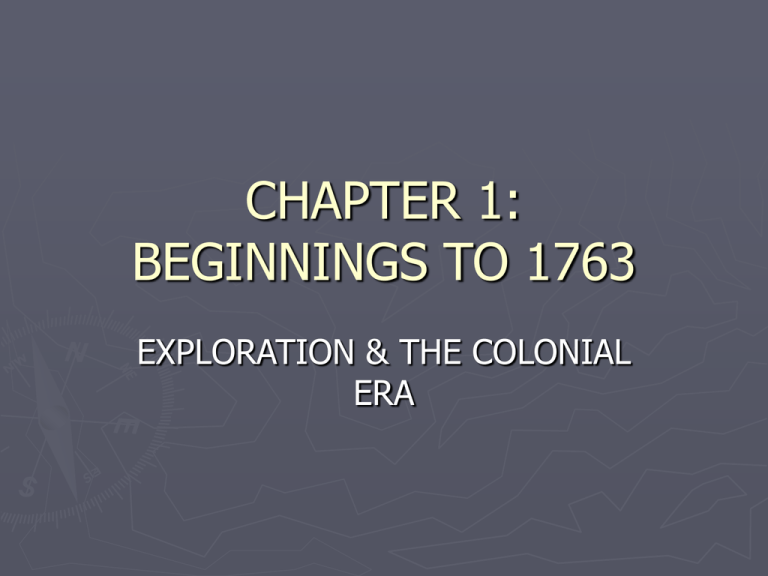
CHAPTER 1: BEGINNINGS TO 1763 EXPLORATION & THE COLONIAL ERA THE AMERICAS, WEST AFRICA, AND EUROPE – SECTION 1 ► ► ► ► ► Ancient Cultures arrived about 22,000 years ago via a land bridge Earliest settlers were hunters Agriculture thrived starting about 5,000 years ago Some Natives remained Nomadic Maya, Aztec, and Inca societies flourished NATIVE AMERICAS IN 1400S ► Native American societies in North America were as varied as the geography ► The Pueblo (SW) and Iroquois (NE) were two famous tribes ► Most of the tribes in America had common religious views, trade patterns & values WEST AFRICAN SOCIETIES OF THE 1400S ► ► ► ► Long established, sophisticated societies existed in Western Africa The Kingdom of Songhai controlled trans-Sahara trade Kingdom of Benin and Kongo were two famous dynasties Village and family bonds formed the basis of life EUROPEAN SOCIETIES OF THE 1400S ► European villages had a long tradition of social hierarchy – complete with nobles, merchants & peasants ► Christianity played a critical role – religious leaders had power ► The Reformation in the early 1500s led to a split in the church Martin Luther EUROPEAN EXPLORATION ► The countries of Portugal, Spain, France and England explored in the late 1400s for God, Gold, and Glory ► Improved mapmaking, better sailboats, compasses, astrolabes, Prince Henry– all led to better exploration SPANISH NORTH AMERICA – SECTION 2 Columbus crosses the Atlantic in October of 1492 and lands in San Salvador (“Holy Savior”) ► He spent about 3 months exploring Islands in the Bahamas ► Europeans used advanced weapons to force locals into labor: Plantation System ► Disease devastated Native population ► IMPACT OF COLUMBUS On Africans- Before slave trade ended in the 1800s, 10 million Africans taken On Europeans- Biggest voluntary migration in world history On Trade- Columbian Exchange meant new goods & products flowed between continents The Columbian Biological Exchange Old World to New World: Diseases: Smallpox Measles Chicken Pox Malaria Yellow Fever Influenza The Common Cold New World to Old World: Syphilis The Columbian Biological Exchange Animals: Old World to New World: Horses Cattle Pigs Sheep Goats Chickens New World to Old World: Turkeys Llamas Alpacas Guinea Pigs The Columbian Biological Exchange Old World to New World: Plants: Rice Wheat Barley Oats Coffee Sugarcane Bananas Melons Olives Dandelions Daisies Clover Ragweed Kentucky Bluegrass New World to Old World: Corn (Maize) Potatoes (White & Sweet Varieties) Beans (Snap, Kidney, & Lima Varieties) Tobacco Peanuts Squash Peppers Tomatoes Pumpkins Pineapples Cacao (Source of Chocolate) Chicle (Source of Chewing Gum) Papayas Manioc (Tapioca) Guavas Avocados SPAIN CLAIMS A NEW EMPIRE ► ► ► ► Spanish explorers (Conquistadors) seized much of the Americas Cortes conquered the Aztecs in Mexico Pizzaro conquered the Incas in Peru Exploitation of local populations was significant – Encomienda System SPAIN EXPLORES SOUTHWEST AND WESTERN AMERICA ► ► ► California Missions ► Mid-1500s, Spain explored much of what is today the SW & West of the USA New Mexico settled by Spanish priest who converted Natives (Pueblos) Texas area had 30 expeditions in 16th century California was site of numerous missions EARLY BRITISH COLONIES – SECTION 3 ► ► ► ► Beginning in the early 1600s, the English established colonies along the eastern coast of North America 1607: Jamestown was first to be settled John Smith led this group of settlers Colony struggled at first, then was saved by Tobacco crop PURITANS CREATE A “NEW ENGLAND” ► The PURITAN, OR “PILGRIM” 16th century Reformation caused a split in the Christian Church; Catholics and Protestants ► One extreme group of Protestant reformers – the Puritans sought to cleanse or “purify” their religion of all traces of Catholicism COLONISTS MEET RESISTANCE ► ► New England Colonists (Puritans) soon conflicted with the Native Americans over land & religion King Philip’s War was fought in 1675 between the Natives and Puritans ending a year later with many dead and the Natives retreating SETTLING THE MIDDLE COLONIES ► Dominated by Dutch and Quaker settlers, the Middle Colonies were founded in the mid-1600s ► William Penn led Quakers as they colonized Pennsylvania and Delaware ENGLAND’S COLONIES PROSPER ► ► ► Throughout the 1600s and 1700s, more British Colonies were established By 1752, the English Crown had assumed more & more responsibility for the 13 colonies Mercantilism & Navigation Acts were two such ways that the English government controlled the colonies King George III MERCANTILISM: AN ECONOMIC SYSTEM IN WHICH NATIONS SEEK TO INCREASE THEIR WEALTH BY OBTAINING GOLD & SILVER AND WITH A FAVORABLE BALANCE OF TRADE MERCANTILISM NAVIGATION ACTS 1651- England’s Parliament passed a series of laws known as the Navigation Acts ► These laws restricted the colonies shipping & trade ► Ships, destinations, crews, goods: All strictly regulated by the English ► The colonies were developing a spirit of selfdetermination. Therefore, they were NOT happy with these restrictions ► THE COLONIES COME OF AGE – SECTION 4 ► ► ► New England, Middle Colonies, and the South – all developed distinct economies and societies In the South, rural Plantations with a single cash crop were common Small Southern farmers (Germans, Scots, Irish) and African slaves made up the majority of people Southern Plantation THE MIDDLE PASSAGE ► During the 17th century, Africans endured a transatlantic crossing from Africa to the North American Colonies ► Cruelty characterized the months long journey – 13% died on route AFRICANS MAINTAIN PARTS OF THEIR CULTURE Despite enslavement, Africans coped with the horrors of slavery via music, dance, and storytelling ► Slaves also resisted their position of subservience by faking illness, breaking tools, or work slowdowns ► Others were more radical and tried escape & revolt ► NORTHERN COLONIES COMMERCE THRIVES LIBERTY BELL ► ► ► The development of cities, expansion of trade, and diverse economies gradually made the North radically different from the South Philly was the 2nd largest British port Farming differed from the South: smaller, more diverse crops in North THE ENLIGHTENMENT AND THE GREAT AWAKENING ► ► ► 1700s: An intellectual movement known as the Enlightenment began in Europe and a religious movement known as the Great Awakening started in the Colonies The Enlightenment emphasized reason, science, and observation and led to the discovery of natural laws Copernicus, Galileo, Franklin and Newton were key figures RELIGIOUS REVIVAL: THE GREAT AWAKENING ► ► ► ► A series of religious revivals aimed at restoring devotion & piety swept through the colonies in the mid-1700s Jonathan Edwards was a Puritan priest from New England who was instrumental in the movement Fire & Brimstone style of worship; large, emotionally charged crowds Like the Enlightenment the movement stressed the importance of the individual FRENCH AND INDIAN WAR ► ► ► ► Competition in North America led to a war (1754-1763) between old rivals France and England The French in North America were tradesmen (furs) not long-term inhabitants Ohio River valley was the site of the conflict The Colonists supported the British while the Natives supported the French FRENCH INDIAN WAR BY NAT YOUNGBLOOD BRITAIN DEFEATS AN OLD ENEMY While the French had early victories, the British led by William Pitt and George Washington eventually defeated the French ► Treaty of Paris ends the war in 1763 ► Brits claim most of North America including Florida (from French ally Spain) & Canada ► Native Americans also realized a French loss was a Native American loss ► WILLIAM PITT ON A COIN PROCLAMATION LINE OF 1763 ► ► To avoid further costly conflicts with Native Americans, the British government prohibited colonists from settling west of the Appalachian Mountains The Proclamation established a line along the Appalachian that colonists could not cross (They did anyway)

